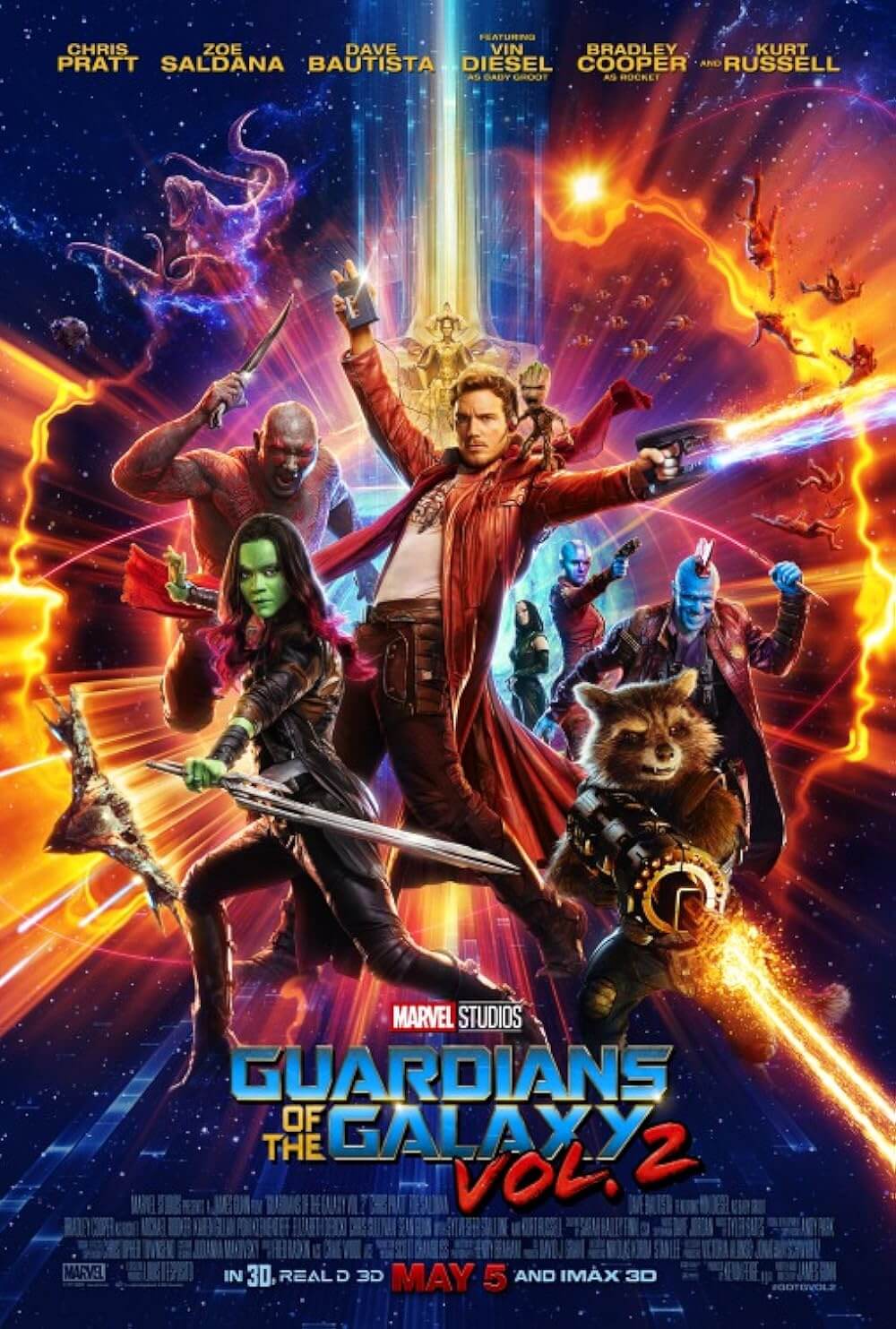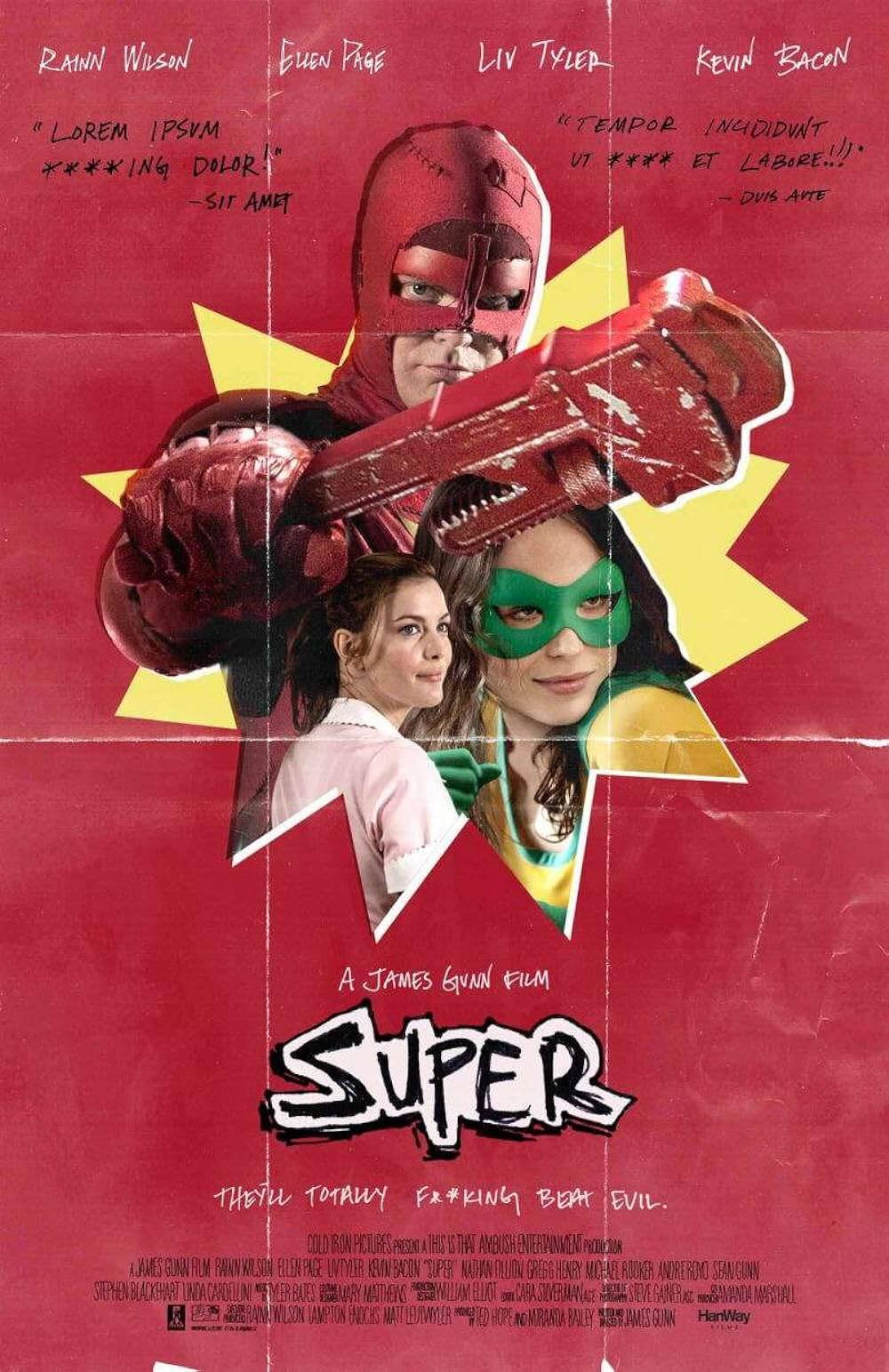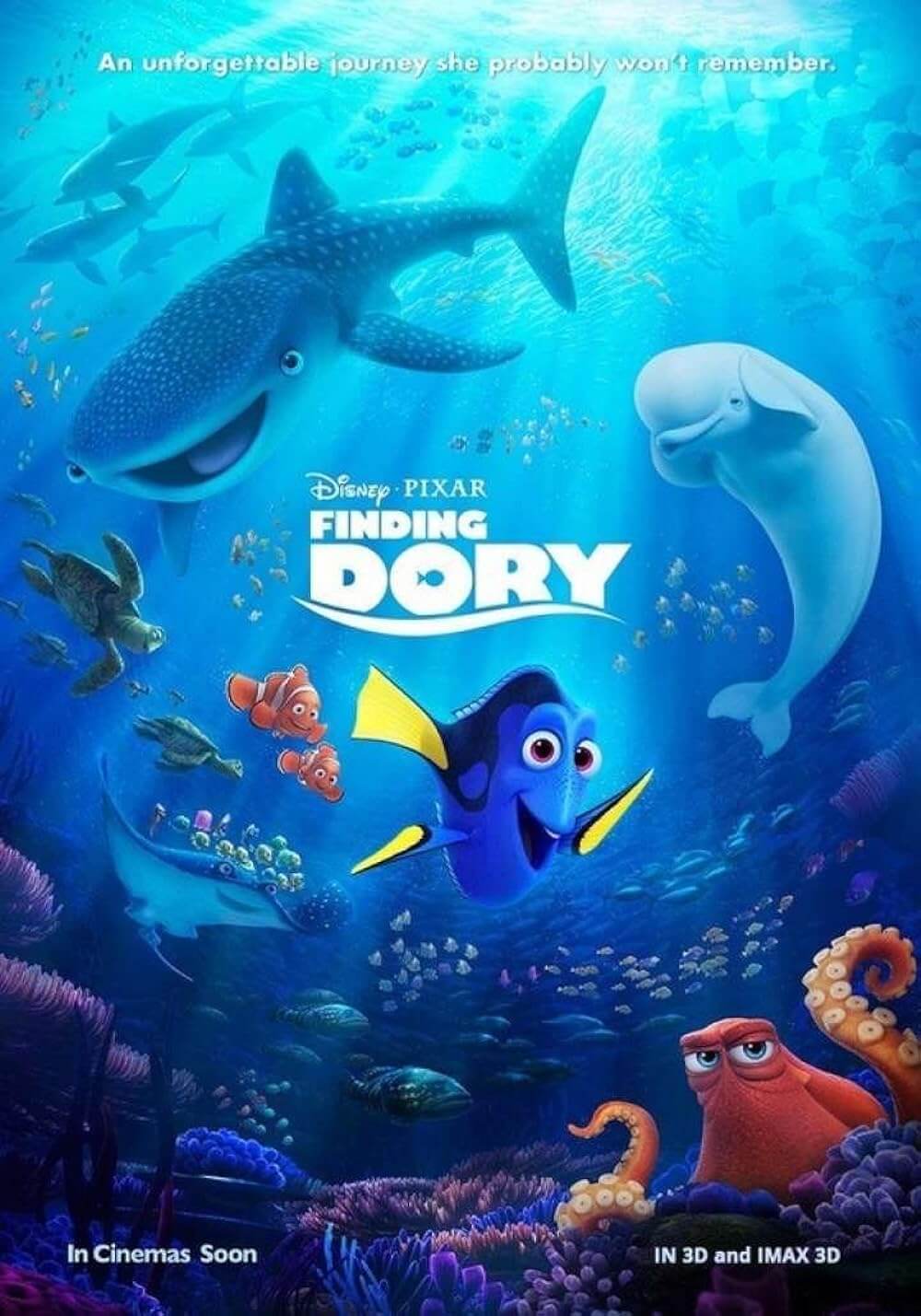The Definitives
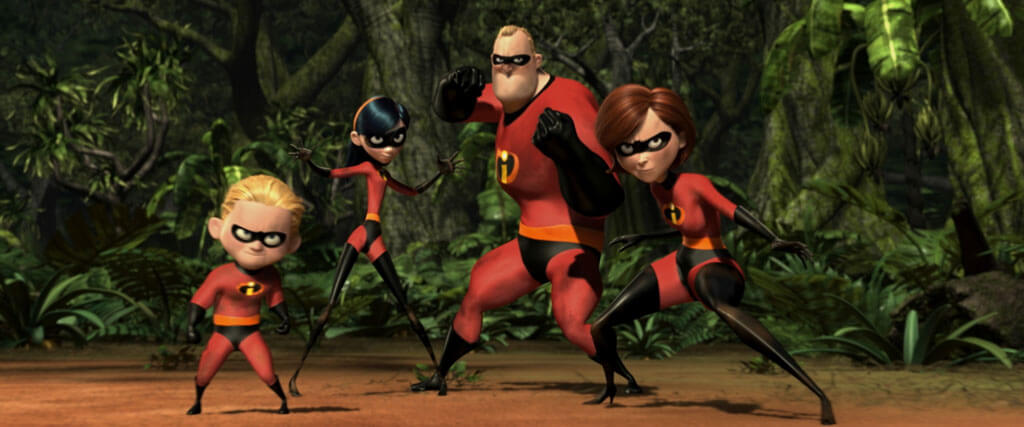
The Incredibles
Essay by Brian Eggert |
Brad Bird made The Incredibles to appeal to everyone, but the film offers more for adults than its presumed target audience, children. To be sure, most Pixar Animation Studios releases connect with viewers universally, across multiple demographics. The beautiful and lively animated release from 2004 offers entertainment for the entire family by way of superhero costumes and humor. The surface of comic book imagery, bright colors, and physical humor belongs to children; a strain of teenage angst, along with a message about the challenges of growing up, appeals to adolescents; but the writer-director tailored much of the film’s emotional substance, aesthetic influence, and subtexts for adults. A pastiche of influences congealed into a fascinating and highly readable whole, The Incredibles finds Pixar at its height, forging a vision of the Golden Age of superheroes with a dramatic reality. It’s innovative, even prophetic in the superhero realm, with a thematic richness that most live-action titles in this genre rarely achieve, regardless of their saturation in the marketplace. And while Bird’s film resonates with anyone, his devotion to engaging a middle-age audience has ensured The Incredibles a venerable place in film history, as it continues to grow along with its viewer.
Hollywood’s obsession with superheroes began in the early 2000s. Bryan Singer’s X-Men (2000) and Sam Raimi’s Spider-Man (2002) proved that Marvel Comics icons could turn monumental profits, while disappointments like Daredevil starring Ben Affleck and Ang Lee’s Hulk, both released in 2003, demonstrated that audiences wanted more than just recognizable intellectual properties. For every formative advancement in the genre such as Spider-Man 2 (2004) or Batman Begins (2005), there were shockingly misguided efforts like The League of Extraordinary Gentlemen (2003) and Catwoman (2004). In the subsequent years, filmmakers like Christopher Nolan and James Mangold sought to elevate superhero franchises with gravitas, even R-ratings. But the early 2000s were a period of drastic highs and lows, a trend that continues given the quality disparity between MCU and DCEU titles today. In this arena, Bird made The Incredibles for Pixar. He conceived the idea before he joined Pixar in 2000, envisioning the film in a similar throwback style to his debut 2-D animated feature, The Iron Giant from 1999, with the unconventional themes of Alan Moore’s graphic novel, The Watchmen.
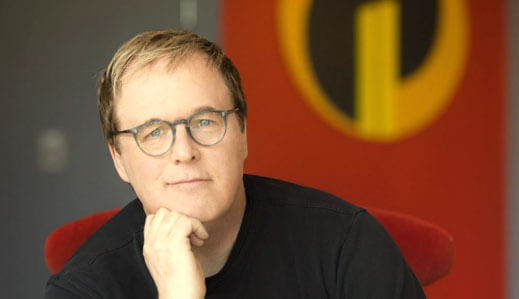 The Incredibles was Bird’s first film at Pixar, though his interest in animation and superheroes went back to his childhood. Born in 1957, he attended Disney’s prestigious animation program at CalArts at the same time as Pixar’s John Lasseter, and together, they believed animation could achieve much more than Walt Disney animated pictures. They aimed for Hayao Miyazaki and beyond. Similar to Lasseter, Bird worked for Disney, and later Lucasfilm, and finally resolved to go independent. One of his animated shorts called Family Dog caught the eye of Steven Spielberg, and before long Bird was hired to write an episode of the 1980s television series Amazing Stories. Later, he was asked to expand Family Dog into an episode of the show. In the coming years, Bird worked on various animated sitcoms for adult audiences, such as The Simpsons and The Critic, while trying and failing to convince Hollywood studios to back a feature-length project. Warner Bros. finally gave Bird the chance to direct the aforementioned masterwork, The Iron Giant, a 1950s-inflected tale of Cold War paranoia and anti-war sentiments. With a modest budget and tight production schedule, Bird released a film that was under-promoted and unappreciated in its day, though today many consider it to be his best film.
The Incredibles was Bird’s first film at Pixar, though his interest in animation and superheroes went back to his childhood. Born in 1957, he attended Disney’s prestigious animation program at CalArts at the same time as Pixar’s John Lasseter, and together, they believed animation could achieve much more than Walt Disney animated pictures. They aimed for Hayao Miyazaki and beyond. Similar to Lasseter, Bird worked for Disney, and later Lucasfilm, and finally resolved to go independent. One of his animated shorts called Family Dog caught the eye of Steven Spielberg, and before long Bird was hired to write an episode of the 1980s television series Amazing Stories. Later, he was asked to expand Family Dog into an episode of the show. In the coming years, Bird worked on various animated sitcoms for adult audiences, such as The Simpsons and The Critic, while trying and failing to convince Hollywood studios to back a feature-length project. Warner Bros. finally gave Bird the chance to direct the aforementioned masterwork, The Iron Giant, a 1950s-inflected tale of Cold War paranoia and anti-war sentiments. With a modest budget and tight production schedule, Bird released a film that was under-promoted and unappreciated in its day, though today many consider it to be his best film.
During the mid-1990s, Bird imagined another story set amid the paranoid era of the Cold War, an homage to 1960s spy films and comic books. As he outlined the story threads, he tried to balance his personal and professional lives. His wife had given birth to their third child, and professionally Bird remained an unproven talent, at least according to his own ambitions—he sought to become the Martin Scorsese or Francis Ford Coppola of animation. Middle-aged, and weighing his artistic ambitions against his family obligations, Bird worked through his woes on the written page, exploring his looming midlife crisis in a story about a family of superheroes not unlike the Fantastic Four of Marvel Comics fame. Similarly middle-aged and trapped between home and a desire for heroic recognition, his characters could work through their existential dilemmas as Bird could not—by saving the day in a sweeping family adventure. Except, of course, Bird eventually became the hero of his own story. In 2000, Bird pitched his superhero concept to Lasseter and company, and Pixar was sold on the idea.
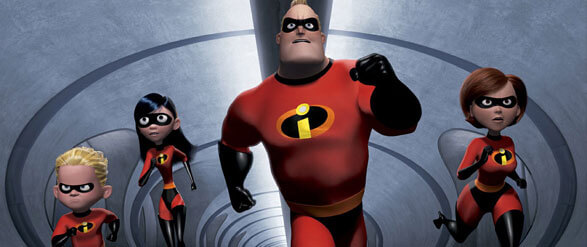 The production of The Incredibles was unique for Pixar. Typically, a team of writers and often two directors handled any Pixar feature: A Bug’s Life (1998) was directed by Lasseter and Andrew Stanton, and five credited writers penned the screenplay; Monsters, Inc. (2001) had Pete Docter and David Silverman at the helm, with a whopping twelve writers attached to the story and screenplay; Stanton and Lee Unkrich directed the Finding Nemo (2003) script, written by three screenwriters. Bird broke the Pixar mold entirely, approaching his film like an auteur. He remained the sole credited director and writer, and he personally oversaw storyboards, character blocking, camera movements, lighting designs, and the dialogue recording. Whereas a standard Pixar production would have department heads dedicated to each of these areas, Bird was committed to his vision and delegated to each department to carry it out. His demand for quality visuals, despite this being his first foray into computer animation, challenged Pixar animators. For example, developers were forced to write a new algorithm to create a more lifelike model for human skin—to avoid looking too blocky, but also not devolve into the too realistic Uncanny Valley. Of course, all of Bird’s demands paid off when The Incredibles became a massive hit for Pixar, earning over $633 million worldwide.
The production of The Incredibles was unique for Pixar. Typically, a team of writers and often two directors handled any Pixar feature: A Bug’s Life (1998) was directed by Lasseter and Andrew Stanton, and five credited writers penned the screenplay; Monsters, Inc. (2001) had Pete Docter and David Silverman at the helm, with a whopping twelve writers attached to the story and screenplay; Stanton and Lee Unkrich directed the Finding Nemo (2003) script, written by three screenwriters. Bird broke the Pixar mold entirely, approaching his film like an auteur. He remained the sole credited director and writer, and he personally oversaw storyboards, character blocking, camera movements, lighting designs, and the dialogue recording. Whereas a standard Pixar production would have department heads dedicated to each of these areas, Bird was committed to his vision and delegated to each department to carry it out. His demand for quality visuals, despite this being his first foray into computer animation, challenged Pixar animators. For example, developers were forced to write a new algorithm to create a more lifelike model for human skin—to avoid looking too blocky, but also not devolve into the too realistic Uncanny Valley. Of course, all of Bird’s demands paid off when The Incredibles became a massive hit for Pixar, earning over $633 million worldwide.
Unlike every earlier Pixar film, which often anthropomorphized inanimate objects or animals, The Incredibles is entirely about human characters. Bird’s cast consists of Mr. Incredible, voiced by Craig T. Nelson, a super-strong paterfamilias type living under the alias Bob Parr. His wife, Helen, aka Elastigirl (Holly Hunter), whose stretchy superpowers resemble Mister Fantastic, endures Bob’s midlife crisis and tries to maintain their home. Their shy teenage daughter, Violet (Sarah Vowell), lives an insecure existence behind the hair in her face, and similar to the Invisible Woman, she can disappear and has protective shields to hide behind. Their boy, Dash (Michael Bird), is a hyperactive ten-year-old with the super-speed to prove it. Meanwhile, their newborn Jack-Jack is full of budding potential, and therefore his powers remain undefined, if expansive. Bird wrote each character with a power that reflects their personality, from the outward strength of the father to the malleability of the mother, to the seemingly obvious descriptions for the children (the angsty teen, the hyperactive boy, the baby with boundless potential). The characters were also constructed within classical tropes for the American nuclear family of the 1960s.
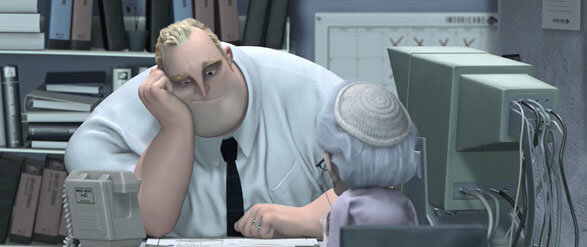 Anticipating many of the thematic concerns that would prevail in later superhero films, The Incredibles considered questions about the real-life consequences of superhero action, long before they were raised in The Dark Knight trilogy, Batman v Superman: Dawn of Justice (2016), and Captain America: Civil War (2016). The prologue finds Mr. Incredible saving a building jumper from committing suicide, only to later find himself sued because the would-be victim “didn’t ask to be saved.” The concept posits that the Golden Age of superheroes is over; the age of joyless reality has begun. With this change, government-sponsored superheroes become the target of personal injury lawsuits that find superheroes culpable for collateral damage. Payouts, with the checks written by the federal government, represent too many taxpayer dollars for the administration to continue paying, and so superheroes retire, enlisting in a federally sponsored relocation program in which they retreat from the public eye. Mr. Incredible and Elastigirl resign to become Bob and Helen Parr. Three children later, they have settled firmly into residential life, with Helen keeping the family together as Bob, now a wage slave in the bureaucratic world of insurance, spends his evenings reminiscing about his glory days with Lucius (Samuel L. Jackson), formerly the ice-slinging Frozone.
Anticipating many of the thematic concerns that would prevail in later superhero films, The Incredibles considered questions about the real-life consequences of superhero action, long before they were raised in The Dark Knight trilogy, Batman v Superman: Dawn of Justice (2016), and Captain America: Civil War (2016). The prologue finds Mr. Incredible saving a building jumper from committing suicide, only to later find himself sued because the would-be victim “didn’t ask to be saved.” The concept posits that the Golden Age of superheroes is over; the age of joyless reality has begun. With this change, government-sponsored superheroes become the target of personal injury lawsuits that find superheroes culpable for collateral damage. Payouts, with the checks written by the federal government, represent too many taxpayer dollars for the administration to continue paying, and so superheroes retire, enlisting in a federally sponsored relocation program in which they retreat from the public eye. Mr. Incredible and Elastigirl resign to become Bob and Helen Parr. Three children later, they have settled firmly into residential life, with Helen keeping the family together as Bob, now a wage slave in the bureaucratic world of insurance, spends his evenings reminiscing about his glory days with Lucius (Samuel L. Jackson), formerly the ice-slinging Frozone.
Bird’s story finds Bob broken out of his suburban malaise by a mysterious woman, Mirage (Elizabeth Peña), who claims to be from a top-secret division of the government. Mirage offers him the chance to don the Mr. Incredible costume again. On a secret island location, Mr. Incredible will help a clandestine scientist test and improve his robotic inventions. This requires that Bob keep secrets from Helen, who wants her husband to protect the family by not taking unnecessary risks; instead, he lies about going on business trips, while in actuality he’s away at a futuristic base, eating shrimp cocktail and living the good life. (Had the film not been rated PG, one could imagine an affair between Mr. Incredible and Mirage). But he soon learns that his trips have provided a new nemesis—Syndrome (Jason Lee), the grown-up version of an admiring fan Mr. Incredible snubbed in his superhero heyday, whose only power is a knack for gadgetry—with the information a learning robot needs to destroy him. Syndrome has slain dozens of superheroes like this. Ultimately, Syndrome’s Master Plan involves faking an alien invasion. He will send his bot to destroy the mainland, and then, just at the right moment, Syndrome will arrive in the guise of a superhero to save the day. But once Helen investigates where her husband has been going on these “business trips,” she sets aside her jealousy and anger to reluctantly assemble her super-family to rescue her husband, stop Syndrome, and save the day.
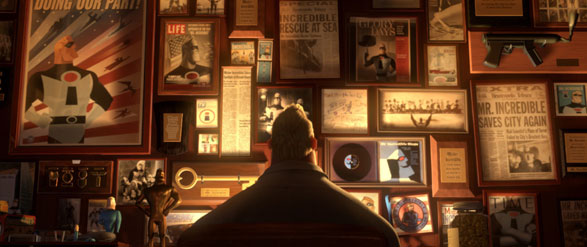 Curiously, the greatest influence on Bird’s plot structure and stylistic approach come from a lookbook of 1960s aesthetics. Having grown up during the 1960s, his choice of visual and story elements make The Incredibles into an appropriation of and nostalgia for spy tropes from the era, including several nods to the James Bond franchise and television shows like Mission: Impossible and The Man from U.N.C.L.E. Above all, Bird draws from Dr. No (1962) and From Russia with Love (1963), complete with a volcanic island paradise that doubles as a secret lair and a seductress secretly working for the bad guy. The resident villain, Syndrome, has an army of anonymous goons in matching uniforms, busying themselves about the high-tech surroundings. Syndrome’s cohort, Mirage, is the “Bond girl” trope who lures our hero to the evil genius, only to realize through her seduction that she’s developed feelings for him (Mirage also first contacts Mr. Incredible with a message that will self-destruct in three seconds à la Mission: Impossible). Moreover, the visual designs throughout recall the clean lines and strong silhouette graphics of Saul Bass, whose prominent work in the 1950s and 1960s shaped many a title sequence and movie poster.
Curiously, the greatest influence on Bird’s plot structure and stylistic approach come from a lookbook of 1960s aesthetics. Having grown up during the 1960s, his choice of visual and story elements make The Incredibles into an appropriation of and nostalgia for spy tropes from the era, including several nods to the James Bond franchise and television shows like Mission: Impossible and The Man from U.N.C.L.E. Above all, Bird draws from Dr. No (1962) and From Russia with Love (1963), complete with a volcanic island paradise that doubles as a secret lair and a seductress secretly working for the bad guy. The resident villain, Syndrome, has an army of anonymous goons in matching uniforms, busying themselves about the high-tech surroundings. Syndrome’s cohort, Mirage, is the “Bond girl” trope who lures our hero to the evil genius, only to realize through her seduction that she’s developed feelings for him (Mirage also first contacts Mr. Incredible with a message that will self-destruct in three seconds à la Mission: Impossible). Moreover, the visual designs throughout recall the clean lines and strong silhouette graphics of Saul Bass, whose prominent work in the 1950s and 1960s shaped many a title sequence and movie poster.
Bird’s commitment to a 1960s aesthetic likewise informs his portrait of family values and how he visualizes them. Accordingly, the characters, while rich with emotional dimensionality and complex personal motivations, represent traditional gender and household roles. The film’s women could hardly be called progressive, for example. Frozone’s unseen wife is little more than a nagging voice off-sceen. Helen, a stay-at-home mother, tends to her family and worries endlessly about her husband. Fortunately, she later shines as the daring Elastigirl when she rescues Mr. Incredible from the clutches of Syndrome. Noting these character descriptions is not to discredit the film or suggest it’s backward or old-fashioned. Helen and the other characters inhabit the notion of the traditional family in U.S. social discourse, aside from their superpowers and alter-egos. By the same token, the Parr’s home looks like a cookie-cutter abode, echoing the familiar ranch-style houses built throughout the United States during this period. Under the protection of the superhero relocation program, the Parrs live in a tract-housing neighborhood that became particularly generalized in the 1960s. And Bob’s office at the insurance company, filled with endless rows of anonymous cubicles and drab, desaturated lighting, reflects the same monotonous quality that The Incredibles associates with lifelessness.
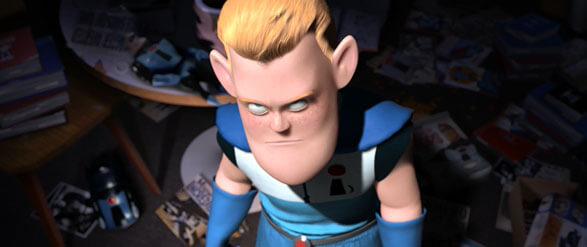
Adopting an ideology of the U.S. circa the 1960s, Bird equates sameness—the unnamed throng of the proletariat—with his appropriately anti-communist viewpoint. The Incredibles rejects the idea of recognition for the unexceptional, a trend in child development and parenting that has become popular in recent decades. Early in the film, Helen reminds Bob about a “graduation” ceremony for Dash moving from fourth to fifth grade. “It’s psychotic!” says Bob. “They keep creating new ways to celebrate mediocrity. But if someone is exceptional…” Helen dismisses her husband’s remarks, though the notion of celebrating mediocrity remains an evil idea for Bob. It comes up again later, when Syndrome announces his Evil Plan: Enraged that he was rejected as a commonplace child by his superhero idol, Syndrome vows to create a line of super-powered gear and make it available to everyday people. “When everyone’s super, no one will be.” Syndrome adopts a communist concept, the stuff of Bond villainy in the 1960s, with its social philosophy attuned to equality of condition. Syndrome is a symptom of the present desire for inclusivity through universal recognition and glorification of mediocre accomplishments. For Bird, celebrating mediocrity robs superness, superheroes, or even just heroes of their merit, and thus deprives everyone else of someone to admire. Humanity needs heroes and positive examples, Bird seems to say; otherwise, we become complacent in our sameness.
Syndrome, then, represents a beacon of dangerous unexceptionalism that threatens the world. In the prologue, as a boy named Buddy, the character wanted to become “Incrediboy” and serve as Mr. Incredible’s sidekick. Having no super-powers besides some rocket-powered boots, Buddy finds himself rejected by his personal hero, and later grows into a resentful villain. Such is the danger of mediocrity, of not being true to one’s Self—it brings out acidic behavior, not to mention an inferiority complex. Through Syndrome, The Incredibles also reflects toxic fanboy culture in the Digital Age. Hollywood has embraced and attempted to satiate the demands of heated fandom, with the understanding that such viewers can often make or break a commercial property, thus giving the audience power and an unchecked ego about having control over franchises like Star Wars. Fanboys have responded by taking jealous ownership of their beloved properties, to the extent that detractors, and even the talent involved in films that fail to appease the masses, have become the target of vitriolic attacks on social media. Bird seems to anticipate this and makes such behavior a characteristic of his film’s villain—a symbol of the film’s theme against mediocrity.
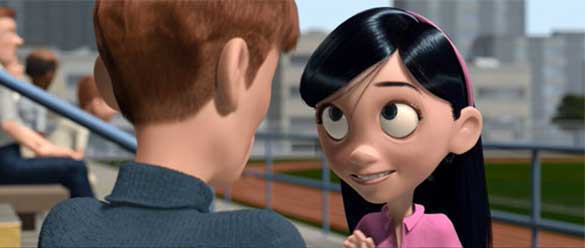 Not all of Bird’s messaging proves as coherent. While The Incredibles seems to denounce sameness and ordinariness as uninteresting, even life-sucking, it also harbors a contradictory sentiment in favor of conformity. Violet’s dramatic arc, for instance, suggests that growing up is tantamount to conformity. Both Dash and Violent experience a coming into one’s own when the situation allows them to grow into their superhero identities—aspects of their lives that were repressed by their parents. By exploring the limits of their powers on Syndrome’s island, or back at the mainland, they realize who they were meant to be. Quite inconsistently, Violet’s growth as a person also means she must transition from dark purple clothing that matches her hair color to the brighter, more socially conforming pink top she wears in the final scenes. She appears at school, now looking normal and fitting in, her hair pulled back behind her ears instead of in her face, and her normality draws the attention of the boy she likes. He might be drawn to her newfound confidence as a superhero; however, the wardrobe and hairstyle change is equivalent to Ally Sheedy’s role in The Breakfast Club (1985), when she transforms from a black-clad outsider doused in black makeup to another ‘80s teen who achieves popularity by taking on a pinkish wardrobe. For Violet, she must deny herself to be accepted—not as a function of her alter-ego, but as a necessary part of growing up. Regrettably, the uneven messages about conformity either being death or leading to maturity remain at odds.
Not all of Bird’s messaging proves as coherent. While The Incredibles seems to denounce sameness and ordinariness as uninteresting, even life-sucking, it also harbors a contradictory sentiment in favor of conformity. Violet’s dramatic arc, for instance, suggests that growing up is tantamount to conformity. Both Dash and Violent experience a coming into one’s own when the situation allows them to grow into their superhero identities—aspects of their lives that were repressed by their parents. By exploring the limits of their powers on Syndrome’s island, or back at the mainland, they realize who they were meant to be. Quite inconsistently, Violet’s growth as a person also means she must transition from dark purple clothing that matches her hair color to the brighter, more socially conforming pink top she wears in the final scenes. She appears at school, now looking normal and fitting in, her hair pulled back behind her ears instead of in her face, and her normality draws the attention of the boy she likes. He might be drawn to her newfound confidence as a superhero; however, the wardrobe and hairstyle change is equivalent to Ally Sheedy’s role in The Breakfast Club (1985), when she transforms from a black-clad outsider doused in black makeup to another ‘80s teen who achieves popularity by taking on a pinkish wardrobe. For Violet, she must deny herself to be accepted—not as a function of her alter-ego, but as a necessary part of growing up. Regrettably, the uneven messages about conformity either being death or leading to maturity remain at odds.
Then again, though mediocrity is undesirable throughout the film, whether it’s the acknowledgment of unexceptional accomplishments or the impetus for Syndrome’s scheme, Mr. Incredible’s arc offers a reconciliation of these ideas. “You are my greatest adventure,” he tells his family, as they prepare for their climactic final battle. “And I almost missed it.” Mr. Incredible and Bob realize that he would rather live with his family than be a superhero without them; family and love present their own kind of being super. Bird seems to argue that, despite being occasionally tedious, love and family surpass even superhero adventures for Bob. Furthermore, by seeking adventure outside of the family, Bob has denied his true Self. And when someone tries to be something they are not, like Syndrome has, they fail to achieve their full potential and become something lesser, something mediocre. When everyone tries to become a superhero, they deny their individuality and superness, and ultimately fail to achieve something monumental—self-actualization. Fortunately for Bob, he also gets to be Mr. Incredible alongside his family of fellow superheroes.
Examples above have detailed The Incredibles’ use of attempted suicide, frivolous lawsuits, insurance bureaucracy, governmental oversight, communistic conformity, personal responsibilities, and self-actualization in its narrative. These are big ideas for an animated family film, but they’re also traditional and timeless ideas that adults more than children will recognize and appreciate. Bird wrote the film’s major narrative elements for an adult audience—more precisely, someone like himself: middle-aged, married with children. In many ways, the film exists as a portrait of Bob and Helen’s marriage. Note the insight into their sex life. When Bob disappears on “business trips,” he returns reinvigorated, as his island getaways allow him to once more become Mr. Incredible. This enhances their sexual frequency (which certainly declined after three children), as evidenced in a shot where Bob begins to leave for work, but Helen pulls him back inside with a come-hither expression. Or watch the moment where Helen slaps Bob on the bottom from across the room, flirting with the help of her elastic abilities. Elsewhere, Bird addresses Helen’s suspicions about Bob’s potential infidelity when she discovers one of Mirage’s blonde hairs on his suit, or she hears Bob talking to another woman on the telephone. The film’s exploration of their relationship is hardly the stuff of typical family entertainment.
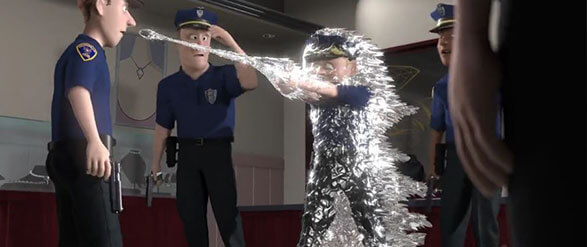 Going further into the arena of mature filmmaking, watching The Incredibles in the post-Black Lives Matter era, an early scene stands out. Bob and Lucius, pining for their former days as superheroes, mount a rescue mission at a nearby building fire and hide their identities behind masks. Their efforts crash-land them through the wall of a jewelry store. The alarm goes off, prompting a police response. A nervous white cop arrives, his gun aimed at Lucius, a black man, but not at Bob, the white perp. Unarmed and dehydrated, Lucius is helpless. He reaches for a cup of water to hydrate, which will allow his freezing powers to create ice and protect himself. Bob and Lucius must escape, as they’re not supposed to be using their super-powers—a mandate of their relocation program. The panicking white police officer keeps telling Lucius to “Freeze!” Lucius calmly replies, “I’m just… getting… a drink.” But the officer shoots at the unarmed Lucius, who fortunately freezes the officer and his bullet at the last moment. It’s a germane moment, with shocking implications for a Pixar film, and it reminds viewers that Bird is an unconventional filmmaker working in the field of Hollywood animation.
Going further into the arena of mature filmmaking, watching The Incredibles in the post-Black Lives Matter era, an early scene stands out. Bob and Lucius, pining for their former days as superheroes, mount a rescue mission at a nearby building fire and hide their identities behind masks. Their efforts crash-land them through the wall of a jewelry store. The alarm goes off, prompting a police response. A nervous white cop arrives, his gun aimed at Lucius, a black man, but not at Bob, the white perp. Unarmed and dehydrated, Lucius is helpless. He reaches for a cup of water to hydrate, which will allow his freezing powers to create ice and protect himself. Bob and Lucius must escape, as they’re not supposed to be using their super-powers—a mandate of their relocation program. The panicking white police officer keeps telling Lucius to “Freeze!” Lucius calmly replies, “I’m just… getting… a drink.” But the officer shoots at the unarmed Lucius, who fortunately freezes the officer and his bullet at the last moment. It’s a germane moment, with shocking implications for a Pixar film, and it reminds viewers that Bird is an unconventional filmmaker working in the field of Hollywood animation.
Fixed with mature themes and rich, human characters to elevate the medium of animation for sophisticated audiences, The Incredibles has a thoughtful consideration of adult relationships, a romanticism about the need for superheroes, and a caution against the decline of Self. It also anticipates emergent trends in the entertainment industry since its release, including the corruption of the relationship between fans and talent, and the prevalence of stories about superheroes who suffocate in real-world bureaucracy. But for Bird, it was a superhero film that reflected his life, using his characters to work through his own preoccupations, thus lending them to a relatable emotional reality. A film of vintage designs and ideas, The Incredibles nonetheless proved ahead of its time, laying out thematic foundations for subsequent filmmakers in the superhero genre to follow. By injecting these elements into a fantastically entertaining animated film, he reached audiences of all ages, making a timeless and enduringly resonant picture that remains an oddity and wonder even in Pixar’s prestigious catalog.
Bibliography:
Herhuth, Eric. Pixar and the Aesthetic Imagination: Animation, Storytelling, and Digital Culture. University of California Press, 2017.
Paik, Karen. To Infinity and Beyond!: The Story of Pixar Animation Studios. Chronicle Books, 2007.
Price, David A. The Pixar Touch. New York: Knopf, 2008.
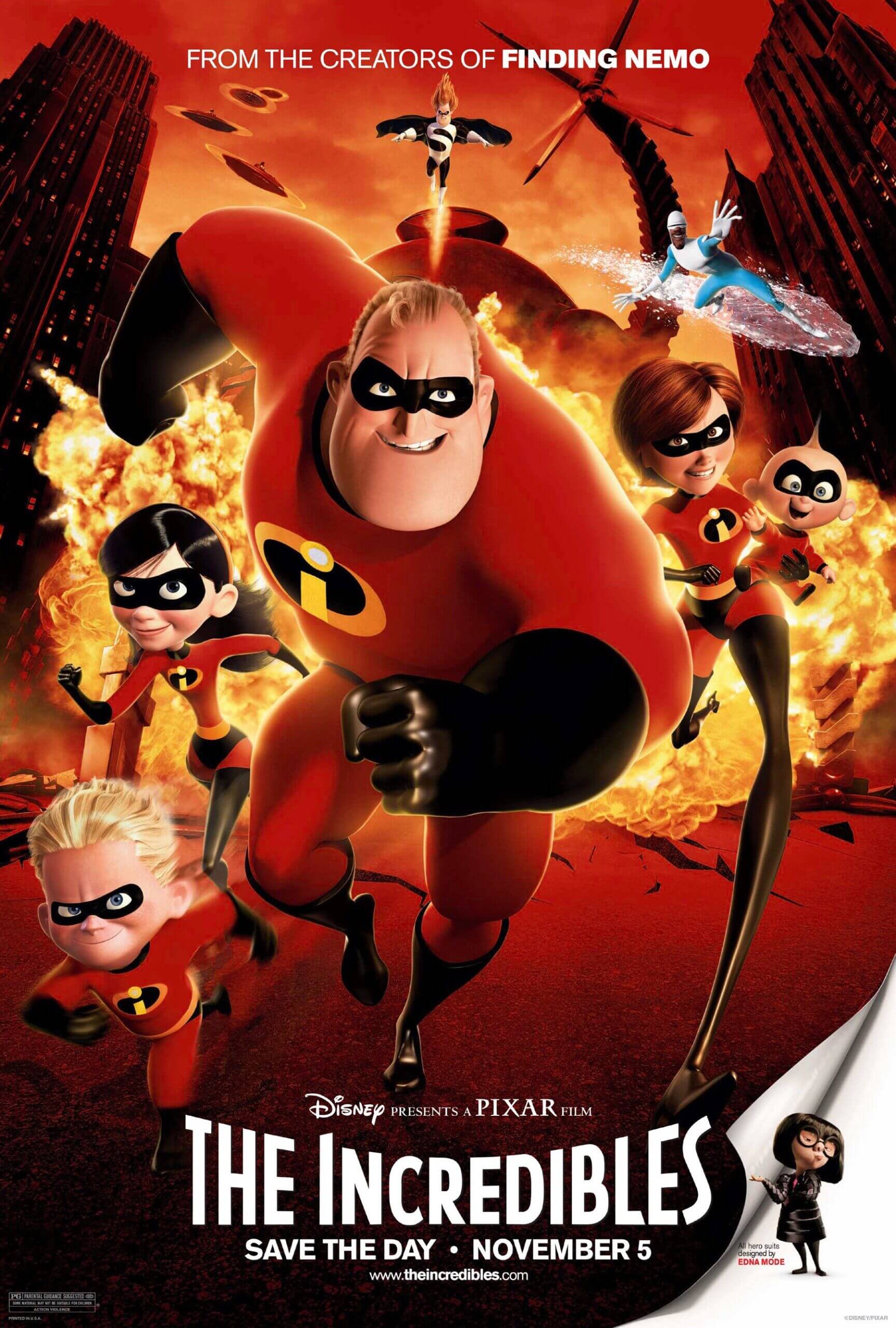
Thank You for Supporting Independent Film Criticism
If the work on DFR has added something meaningful to your love of movies, please consider supporting it.
Here are a few ways to show your support: make a one-time donation, join DFR’s Patreon for access to exclusive writing, or show your support in other ways.
Your contribution helps keep this site running independently. However you choose to support the site, please know that it’s appreciated.
Thank you for reading, and for making this work possible.
Brian Eggert | Critic, Founder
Deep Focus Review


